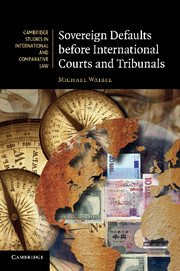Book contents
- Frontmatter
- Contents
- Preface
- Note: measuring sovereign liability over time
- Table of cases
- Table of treaties
- List of abbreviations
- Part I Sovereign defaults across time
- 1 Sovereign debt crises and defaults
- 2 Political responses to sovereign defaults
- 3 Quasi-receivership of highly indebted countries
- 4 Monetary reform and sovereign debt
- 5 Financial necessity
- 6 National settlement institutions
- 7 State succession and the capacity to pay
- 8 Arbitration clauses in sovereign debt instruments
- 9 Creditor protection in international law
- Part II The future role of arbitration on sovereign debt
- Bibliography
- Index
- Cambridge Studies in International and Comparative Law
9 - Creditor protection in international law
Published online by Cambridge University Press: 01 June 2011
- Frontmatter
- Contents
- Preface
- Note: measuring sovereign liability over time
- Table of cases
- Table of treaties
- List of abbreviations
- Part I Sovereign defaults across time
- 1 Sovereign debt crises and defaults
- 2 Political responses to sovereign defaults
- 3 Quasi-receivership of highly indebted countries
- 4 Monetary reform and sovereign debt
- 5 Financial necessity
- 6 National settlement institutions
- 7 State succession and the capacity to pay
- 8 Arbitration clauses in sovereign debt instruments
- 9 Creditor protection in international law
- Part II The future role of arbitration on sovereign debt
- Bibliography
- Index
- Cambridge Studies in International and Comparative Law
Summary
Before World War I, creditors (or their governments) generally failed to obtain compensation before arbitral tribunals and mixed claims commissions. Except in limited circumstances, claims commissions tended to decline ‘pure’ creditor claims. Some tribunals declined compensation to creditors because no clear link of causation ran from a governmental expropriation of some commercial undertaking to injury suffered by the creditor. The creditor suffered only indirect injury. This reluctance to accept creditor claims extended to national courts and claims commissions.
A first shift occurred in the interwar period, though consistency in the claims practice on creditor claims remained lacking. For one, secured debt claims – such as mortgages – started to receive international protection. Mortgages are rights in rem, and closely related to immovable property. In isolated cases, unsecured claims were deemed to benefit from protection under international law too. Most of the time, however, unsecured creditors, or, more precisely, their state of nationality in the days of diplomatic protection, lacked an international law remedy.
Creditor claims raise particular issues of causation and attribution under the secondary rules on state responsibility. In the international law on creditor claims the question of the immediacy of damages looms large. A general rule that any ripple effect of some injury to tangible property on the creditor's contractual rights is compensable has long been regarded as problematic. The tendency was to look at the connection of the creditor's loss with the direct injuries to person or property.
- Type
- Chapter
- Information
- Sovereign Defaults before International Courts and Tribunals , pp. 169 - 206Publisher: Cambridge University PressPrint publication year: 2011



